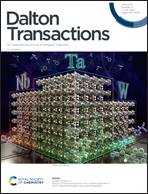Mixed superalkalis are a better choice than pure superalkalis for B12N12 nanocages to design high-performance nonlinear optical materials†
Abstract
Mixed superalkali clusters are a source of excess electrons, as their vertical ionization energies (2.81–3.36 eV) are much lower than those of alkali metals (even cesium (∼3.85 eV)) and the superalkali Li3O (3.42 eV). In the present work, the geometric, electronic, and nonlinear optical (NLO) properties of mixed superalkali cluster-doped B12N12 nanocages are studied theoretically. All complexes, A–G, have very high interaction energies (−98.02 to −123.13 kcal mol−1) and are thermodynamically stable when compared to previously reported Li3O@B12N12 (−92.71 kcal mol−1). The designed complexes have smaller HOMO–LUMO energy gaps (3.36–4.27 eV) than pristine B12N12 (11.13 eV). Charge transfer in the complexes is studied through natural population analysis and non-bonding interactions are evaluated through quantum theory of atoms in molecules (QTAIM) and non-covalent interaction analyses. These complexes have absorption maxima (1076–1486 nm) in the near-infrared region (NIR) and they are transparent in the UV region. The first hyperpolarizability of complex C is 1.7 × 107 au, which is much higher than the value of 3.7 × 104 au for a pure Li3O superalkali-doped B12N12 complex calculated at the same level of theory, as reported by Sun et al. (Dalton Trans., 2016, 45, 7500–7509). The large second hyperpolarizability values also reflect the enhanced nonlinear optical response. The best computed values for the electro-optical Pockels effect, second harmonic generation, and hyper-Rayleigh scattering are 3.29 × 1010 au, 1.17 × 1010 au, and 6.71 × 106 au, respectively. Furthermore, the electro-optic dc-Kerr effect and electric-field-induced second harmonic generation have maximum values of 3.96 × 1011 au and 3.46 × 1010 au at 1064 nm. There are enhancements in the quadratic nonlinear refractive index (n2) values for complexes A–G, with a highest n2 value of 3.35 × 10−8 cm2 W−1 at 1064 nm. These results suggest that mixed-superalkali-doped B12N12 nanoclusters are potential candidates when designing high-performance NLO materials.



 Please wait while we load your content...
Please wait while we load your content...